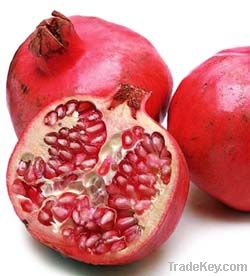

FOB Price
Get Latest Price25 USD / Kilogram
|25 Kilogram Minimum Order
Country:
China
Model No:
20%, 25%, 30%, 40% punicalagins
FOB Price:
25 USD / Kilogram Get Latest Price
Place of Origin:
China
Price for Minimum Order:
25 per Kilogram
Minimum Order Quantity:
25 Kilogram
Packaging Detail:
20kg/25kg/paper drum
Delivery Time:
10days
Supplying Ability:
200 Kilogram per Day
Payment Type:
T/T
Product Group :
Contact Person Andy
Xicheng Road, Guilin, Guangxi
A pomegranate ( /ˈpɒm.ɪ.ɡræn.ət/), Punica granatum, is a fruit-bearing deciduous shrub or small tree growing between five and eight meters tall. The pomegranate is native to the Caucasus, the Himalayas in north Pakistan and Northern India.
It has been cultivated in the Caucasus since ancient times, and today, is widely cultivated throughout Iran, Azerbaijan, Afghanistan, India, Pakistan, Bangladesh, Iraq, Egypt, China, Burma, Saudi Arabia, Israel, Jordan, the drier parts of southeast Asia, the Mediterranean region of Southern Europe, and tropical Africa. Introduced into Latin America and California by Spanish settlers in ***9, pomegranate is now cultivated in parts of California and Arizona for juice production.
In the Northern Hemisphere, the fruit is typically in season from September to February. In the Southern Hemisphere, it is in season from March to May.
The pomegranate is a very ancient fruit, mentioned in the
Homeric Hymns and
the Book of
Exodus.Yet, it has still to reach mainstream prominence in
the commercial markets of North America and the Western
Hemisphere.
Nutrients and phytochemicals
Pomegranate aril juice provides about *6% of an adult's daily vitamin C requirement per **0 ml serving, and is a good source of vitamin B5 (pantothenic acid), potassium and polyphenols, such as tannins and flavonoids.
Pomegranates are listed as high-fiber in some charts of nutritional value. That fiber, however, is entirely contained in the edible seeds which also supply unsaturated oils. People who choose to discard the seeds forfeit nutritional benefits conveyed by the seed fiber, oils and micronutrients.
The most abundant polyphenols in pomegranate juice are the hydrolyzable tannins called ellagitannins formed when ellagic acid binds with a carbohydrate. Punicalagins are tannins with free-radical scavenging properties in laboratory experiments and with potential human effects.Punicalagins are absorbed into the human body and may have dietary value as antioxidants, but conclusive proof of efficacy in humans has not yet been shown. During intestinal metabolism by bacteria, ellagitannins and punicalagins are converted to urolithins which have unknown biological activity in vivo.
Other phytochemicals include polyphenolic catechins, gallocatechins, and anthocyanins, such as prodelphinidins, delphinidin, cyanidin, and pelargonidin. The ORAC (antioxidant capacity) of pomegranate juice was measured at 2,**0 units per **0 grams.
Many food and dietary
supplement makers use pomegranate phenolic extracts as
ingredients in their products instead of the juice. One of these
extracts is ellagic
acid, which may become bioavailable only after parent
molecule punicalagins are metabolized.
However, ingested ellagic acid from pomegranate juice does not
accumulate in the blood in significant quantities and is rapidly
excreted.Accordingly, ellagic acid from pomegranate juice does
not appear to be biologically important in vivo.
| Country: | China |
| Model No: | 20%, 25%, 30%, 40% punicalagins |
| FOB Price: | 25 / Kilogram Get Latest Price |
| Place of Origin: | China |
| Price for Minimum Order: | 25 per Kilogram |
| Minimum Order Quantity: | 25 Kilogram |
| Packaging Detail: | 20kg/25kg/paper drum |
| Delivery Time: | 10days |
| Supplying Ability: | 200 Kilogram per Day |
| Payment Type: | T/T |
| Product Group : | powder extracts |